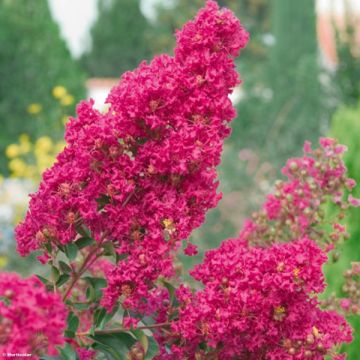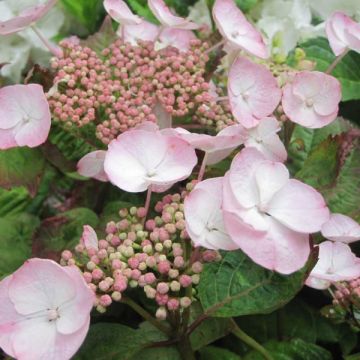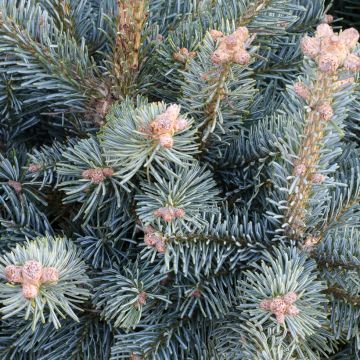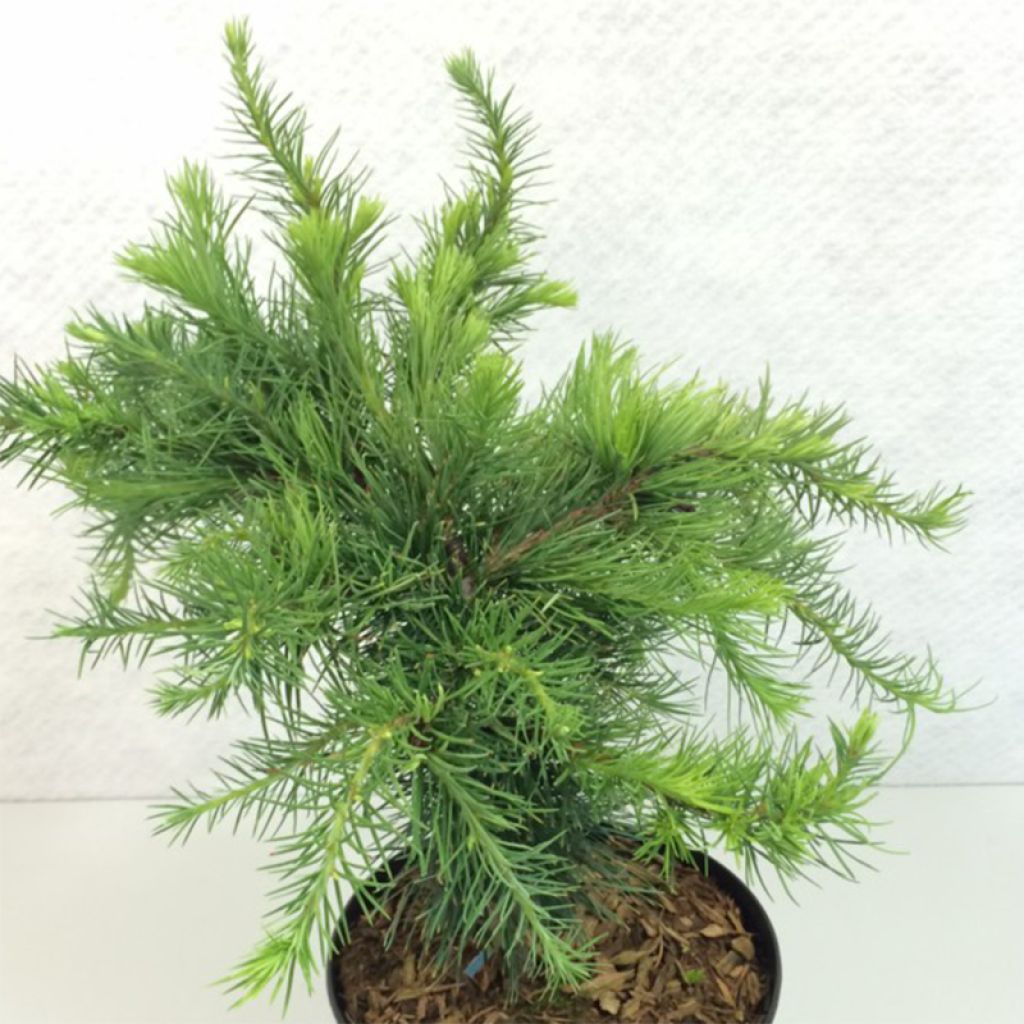

Larix decidua Little Bogle - Mélèze d'Europe nain
Larix decidua Little Bogle - Larch
Larix decidua Little Bogle
European Larch, Common Larch
Why not try an alternative variety in stock?
View all →This plant carries a 24 months recovery warranty
More information
We guarantee the quality of our plants for a full growing cycle, and will replace at our expense any plant that fails to recover under normal climatic and planting conditions.
Oversize package: home delivery by special carrier from €6.90 per order..
Express home delivery from €8.90.

Does this plant fit my garden?
Set up your Plantfit profile →
Description
The Larix decidua 'Little Bogle' is one of the rare dwarf forms of the European larch. This deciduous conifer shows a bushy and very tormented habit, and covers itself in the spring with light green needles, darkening to bluish green, becoming golden yellow in autumn. It is perfect in a rockery and lends itself perfectly to the art of bonsai. Very hardy, this montane variety appreciates light and cool soil, without too much limestone, even poor, and sunny exposure.
The European larch, Larix decidua, is a large conifer that can reach 30 m (98 ft 5 in) in height, with deciduous foliage. It is native to the mountains of central and southern Europe, at an altitude between 1400 and 2400 m (4593 ft 2 in and 7874 ft). It is a pioneer species capable of improving poor or degraded soils, with great hardiness (up to -40°C (-40 °F)). Highly appreciated for its wood, it adapts very well to cultivation in the plain. It belongs to the family of Pinaceae, such as pines, firs and spruces. It is a species very close to the Japanese Larix kaempferi.
The Larix decidua or Larix kaempheri 'Little Bogle' forms after 10 years a small bushy and compact shrub, with a rounded then pyramidal habit, measuring from 50 cm (19.7 in) to 1 m (3 ft 4 in) in all directions. Its growth is quite slow. At ripeness, it sometimes reaches 2 m (6 ft 7 in) in all directions. Its branches are very twisted and gracefully tormented, giving it a ghostly appearance in winter, which earned it the name 'Bogle', which means 'Ghost' in Scottish language. In spring, the branches are dressed in bright green tender needles, and are inserted in rosettes on the short branches, or individually on the long branches. They then take on a bluish-green hue before turning golden yellow in autumn. They are grouped in tufts composed of 35 to 40 needles. Covering its twisted trunk, its grey bark becomes reddish-brown and cracks into scales with age.
The dwarf larch 'Little Bogle' is a small conifer of great originality and low requirement, easy to cultivate in a rockery, provided that the soil remains quite fresh and that it is placed in a sunny exposure. It goes well with geometric lines and masonry works. It is also easily grown in pots to decorate the terrace or balcony. It can also be made into a delightful bonsai. The real graphic qualities of conifers naturally impose themselves in the design of a contemporary garden, which prefers the aesthetics of shapes, silhouettes and textures to the waltz of flowerings. These plants durably structure a bed, mark alleys, border terraces, easily substituting the strong presence of pruned boxwood. They associate with dishevelled grasses and heathers whose temperament is very complementary. The whole thing is to play with volumes and colours.
Advice: Water regularly during the first two years, and in cases of prolonged drought. While it accepts a punctually dry soil in a cool climate, this conifer will be disappointing in a dry and hot climate.
Report an error about the product description
Larix decidua Little Bogle - Larch in pictures
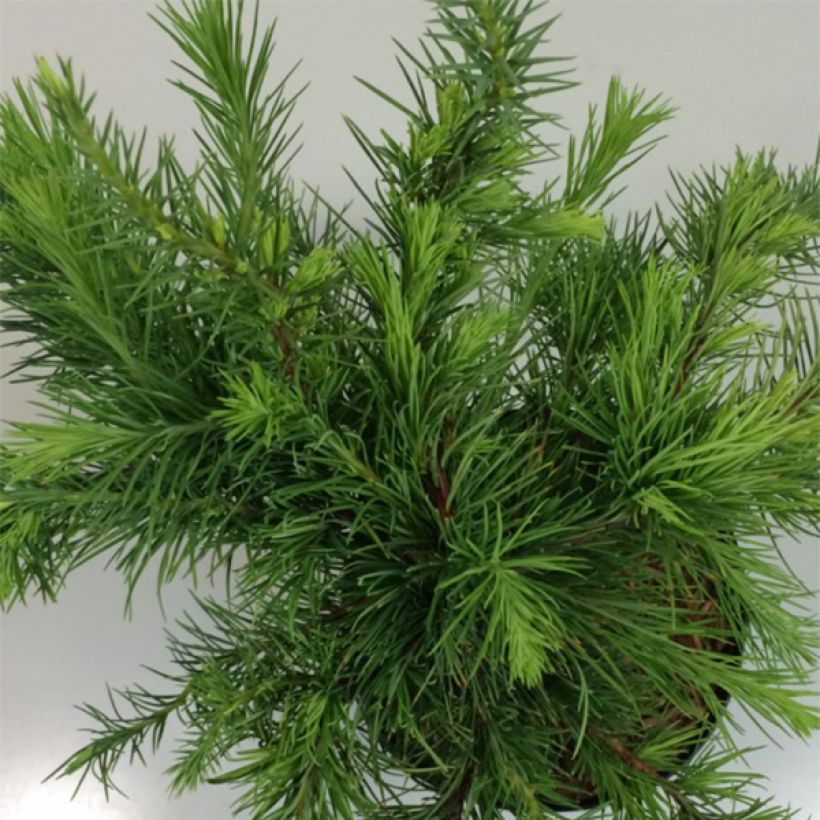



Plant habit
Foliage
Botanical data
Larix
decidua
Little Bogle
Pinaceae
European Larch, Common Larch
Cultivar or hybrid
Other Larix - Larch
Planting and care
The Larix decidua 'Bogle' is a montane climate plant that fears arid situations. It is planted from September to November in well-drained, even poor soil, but that retains freshness, is without excess limestone, in a sunny or semi-shaded location. A mix containing coarse sand, heather soil, and compost added to the garden soil will suit very well. If your soil is too heavy, a small tip is to plant your bush on a mound and mulch it with gravel. Water regularly during the first two years, and in cases of prolonged drought. Soak the clumps well before planting. This very hardy conifer fears heavy, water-logged soil. Pruning is not necessary, but this conifer can be perfectly pruned to maintain or accentuate its original habit. Pruning will take place in February-March.
Planting period
Intended location
Care
-
, onOrder confirmed
Reply from on Promesse de fleurs
Shrubs for pots
Haven't found what you were looking for?
Hardiness is the lowest winter temperature a plant can endure without suffering serious damage or even dying. However, hardiness is affected by location (a sheltered area, such as a patio), protection (winter cover) and soil type (hardiness is improved by well-drained soil).

Photo Sharing Terms & Conditions
In order to encourage gardeners to interact and share their experiences, Promesse de fleurs offers various media enabling content to be uploaded onto its Site - in particular via the ‘Photo sharing’ module.
The User agrees to refrain from:
- Posting any content that is illegal, prejudicial, insulting, racist, inciteful to hatred, revisionist, contrary to public decency, that infringes on privacy or on the privacy rights of third parties, in particular the publicity rights of persons and goods, intellectual property rights, or the right to privacy.
- Submitting content on behalf of a third party;
- Impersonate the identity of a third party and/or publish any personal information about a third party;
In general, the User undertakes to refrain from any unethical behaviour.
All Content (in particular text, comments, files, images, photos, videos, creative works, etc.), which may be subject to property or intellectual property rights, image or other private rights, shall remain the property of the User, subject to the limited rights granted by the terms of the licence granted by Promesse de fleurs as stated below. Users are at liberty to publish or not to publish such Content on the Site, notably via the ‘Photo Sharing’ facility, and accept that this Content shall be made public and freely accessible, notably on the Internet.
Users further acknowledge, undertake to have ,and guarantee that they hold all necessary rights and permissions to publish such material on the Site, in particular with regard to the legislation in force pertaining to any privacy, property, intellectual property, image, or contractual rights, or rights of any other nature. By publishing such Content on the Site, Users acknowledge accepting full liability as publishers of the Content within the meaning of the law, and grant Promesse de fleurs, free of charge, an inclusive, worldwide licence for the said Content for the entire duration of its publication, including all reproduction, representation, up/downloading, displaying, performing, transmission, and storage rights.
Users also grant permission for their name to be linked to the Content and accept that this link may not always be made available.
By engaging in posting material, Users consent to their Content becoming automatically accessible on the Internet, in particular on other sites and/or blogs and/or web pages of the Promesse de fleurs site, including in particular social pages and the Promesse de fleurs catalogue.
Users may secure the removal of entrusted content free of charge by issuing a simple request via our contact form.
The flowering period indicated on our website applies to countries and regions located in USDA zone 8 (France, the United Kingdom, Ireland, the Netherlands, etc.)
It will vary according to where you live:
- In zones 9 to 10 (Italy, Spain, Greece, etc.), flowering will occur about 2 to 4 weeks earlier.
- In zones 6 to 7 (Germany, Poland, Slovenia, and lower mountainous regions), flowering will be delayed by 2 to 3 weeks.
- In zone 5 (Central Europe, Scandinavia), blooming will be delayed by 3 to 5 weeks.
In temperate climates, pruning of spring-flowering shrubs (forsythia, spireas, etc.) should be done just after flowering.
Pruning of summer-flowering shrubs (Indian Lilac, Perovskia, etc.) can be done in winter or spring.
In cold regions as well as with frost-sensitive plants, avoid pruning too early when severe frosts may still occur.
The planting period indicated on our website applies to countries and regions located in USDA zone 8 (France, United Kingdom, Ireland, Netherlands).
It will vary according to where you live:
- In Mediterranean zones (Marseille, Madrid, Milan, etc.), autumn and winter are the best planting periods.
- In continental zones (Strasbourg, Munich, Vienna, etc.), delay planting by 2 to 3 weeks in spring and bring it forward by 2 to 4 weeks in autumn.
- In mountainous regions (the Alps, Pyrenees, Carpathians, etc.), it is best to plant in late spring (May-June) or late summer (August-September).
The harvesting period indicated on our website applies to countries and regions in USDA zone 8 (France, England, Ireland, the Netherlands).
In colder areas (Scandinavia, Poland, Austria...) fruit and vegetable harvests are likely to be delayed by 3-4 weeks.
In warmer areas (Italy, Spain, Greece, etc.), harvesting will probably take place earlier, depending on weather conditions.
The sowing periods indicated on our website apply to countries and regions within USDA Zone 8 (France, UK, Ireland, Netherlands).
In colder areas (Scandinavia, Poland, Austria...), delay any outdoor sowing by 3-4 weeks, or sow under glass.
In warmer climes (Italy, Spain, Greece, etc.), bring outdoor sowing forward by a few weeks.












































